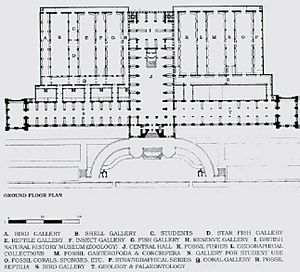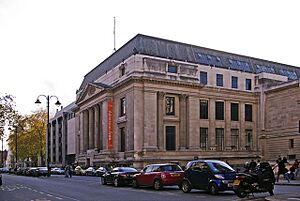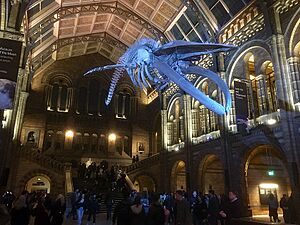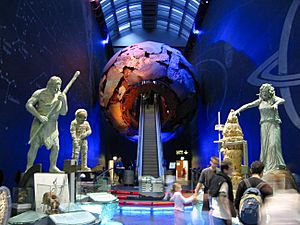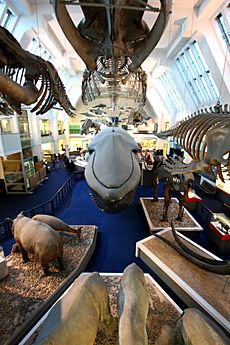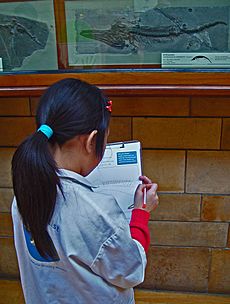Natural History Museum, London facts for kids
The Natural History Museum in London is a super cool place that shows off tons of amazing things from the natural world! It's one of three big museums on Exhibition Road in South Kensington, along with the Science Museum and the Victoria and Albert Museum. You'll find its main entrance on Cromwell Road.
This museum is home to about 80 million items! These include plants, insects, minerals, fossils, and animals. Scientists here study how living things are classified, identified, and how to protect them. Many items are very old and important, like specimens collected by Charles Darwin. The museum is famous for its huge dinosaur skeletons and its beautiful building, which some people call a cathedral of nature. For many years, a giant Diplodocus skeleton cast, nicknamed "Dippy", greeted visitors in the main hall. In 2017, Dippy was replaced by the real skeleton of a huge blue whale hanging from the ceiling! The museum also has a massive library filled with books and art related to natural history research. It's known as one of the best places in the world for natural history and science research.
Even though everyone calls it the Natural History Museum, its official name was "British Museum (Natural History)" until 1992. It became separate from the British Museum in 1963. The famous building, designed by Alfred Waterhouse, opened in 1881. Later, the Geological Museum joined it. The Darwin Centre is a newer part, built to store valuable collections and provide modern research spaces.
Just like other national museums in the UK, you can visit the Natural History Museum for free! It's supported by the government, and The Princess of Wales is a special patron. About 850 people work there, helping visitors and doing scientific research.
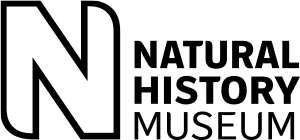 |
|

The front of the museum building in September 2011
|
|
| Lua error in Module:Location_map at line 420: attempt to index field 'wikibase' (a nil value). | |
| Established | 1881 |
|---|---|
| Location | Kensington & Chelsea, London, SW7 United Kingdom |
| Type | Natural history museum |
| Visitors | 5,688,786 in 2023 |
| Founder | Richard Owen |
| Public transit access |
|
Contents
Museum History
How the Museum Started
The museum's first collections came from a doctor named Sir Hans Sloane (1660–1753). He sold his huge collections of dried plants, animal skeletons, and human skeletons to the British government for a very low price. These items were first kept in Montagu House, Bloomsbury, which was also home to the British Museum.
Over time, many of Sloane's original items were lost or damaged. It became clear that the natural history collections needed better care and a dedicated space.
Richard Owen's Vision
The palaeontologist Richard Owen became the Superintendent of the natural history departments in 1856. He realized that these collections needed much more room. He believed they should have their own building, separate from the British Museum. Owen wanted the museum to be a place for everyone, not just scientists. His ideas changed how people thought about museums.
Designing the New Building
Land was bought in South Kensington for the new museum. In 1864, a competition was held to design the building. Captain Francis Fowke won, but he sadly passed away soon after. So, Alfred Waterhouse took over the project in 1866. He changed the plans quite a bit, designing the building in his unique Romanesque style.
Waterhouse worked closely with each department to understand their needs. Construction began in 1873 and finished in 1880. The new museum opened its doors on April 18, 1881. People had mixed feelings about it at first, but most saw it as a great addition to society. The building has been updated over the years, especially after being damaged during World War II.
The inside and outside of the Waterhouse building use lots of special architectural terracotta tiles. These tiles were good at resisting the smoky air of Victorian London. They feature many sculptures of plants and animals. On one side, you can see living species, and on the other, extinct ones. This was a special request from Richard Owen.
The museum's main line-up matches other famous buildings nearby, like Imperial College London and the Royal Albert Hall. Together, these form an area sometimes called Albertopolis.
Becoming Independent
Even after it opened, the Natural History Museum was legally part of the British Museum. Scientists and important groups like the Royal Society asked for it to become independent for almost 100 years. Finally, in 1963, a law was passed that made it an independent museum with its own leaders.
In 1989, the museum started calling itself the Natural History Museum in its advertising. Then, in 1992, another law officially changed its name to the Natural History Museum.
Joining with the Geological Museum
In 1985, the museum joined with the nearby Geological Museum. The Geological Museum was famous for its exhibits, including a model volcano and an earthquake machine. Its galleries were completely rebuilt and reopened in 1996 as The Earth Galleries. The other exhibits in the Waterhouse building became The Life Galleries. The museum's old mineral displays are still there, showing how things were displayed in the 1800s.
A cool design in the central area helps visitors explore the upper floors. It features an escalator that takes you through a model of the Earth. In late 2015, a Stegosaurus skeleton was put on display there.
The Darwin Centre
The Darwin Centre is named after Charles Darwin. It was built to be a new home for the museum's millions of preserved specimens. It also provides modern workspaces for scientists and new ways for visitors to learn. This is the biggest new project in the museum's history.
The first part of the Darwin Centre opened in 2002. It holds the "spirit collections"—animals preserved in alcohol. The second part opened in 2009. It looks like a giant, eight-story cocoon and houses the insect and plant collections. You can even book tours to see some of these amazing collections behind the scenes!
One of the most famous creatures in the Darwin Centre is "Archie," a huge giant squid that is 8.62 meters (about 28 feet) long!
The Attenborough Studio
The museum also has a special multimedia studio called the Attenborough Studio, named after the famous broadcaster Sir David Attenborough. It works with the BBC Natural History Unit to create educational events. The studio hosts regular talks and demonstrations, including free "Nature Live" talks on Fridays, Saturdays, and Sundays.
Famous Exhibits
Dippy the Diplodocus
For many years, one of the most famous exhibits was "Dippy". This was a 105-foot-long (32-meter) replica of a Diplodocus carnegii skeleton. It was a gift from a rich Scottish-American man named Andrew Carnegie in 1905. Dippy quickly became a symbol of the museum and appeared in many cartoons and movies.
After 112 years, Dippy was removed in early 2017. It then went on a tour of different museums across Britain.
Hope the Blue Whale
Replacing Dippy in the main Hintze Hall is "Hope", a real skeleton of a young blue whale. This amazing display is about 82 feet (25 meters) long and weighs 4.5 tonnes! The whale had been stored for 42 years after it got stranded in Ireland in 1891.
In 1934, a life-sized model of a blue whale was also built inside the museum's Whale Hall (now the Mammals gallery). It was the largest model of its kind in the world when it was finished in 1938. The story of removing Dippy and putting up Hope was even shown in a BBC TV show called Horizon: Dippy and the Whale.
Archie the Giant Squid
The Darwin Centre is home to Archie, an incredible 8.62-meter-long (about 28 feet) giant squid. It was caught alive near the Falkland Islands in 2004. Archie isn't on general display, but is kept in a huge tank in the basement of the Darwin Centre. You can book special tours to see it and other "spirit collections" up close. Archie is preserved in a special liquid in a 9.45-meter (31-foot) acrylic tank.
Other Interesting Specimens
- The remains of the "River Thames whale", a whale that swam into the Thames River in 2006, are kept for research.
- Dinocochlea, a mysterious fossil that scientists have studied for a long time, has been in the collection since 1921.
- The museum also has a wildlife garden where a new type of insect was found in 2007!
Museum Zones
The museum is split into four main areas, each with a different color and theme.
Red Zone
You can enter this zone from Exhibition Road. It's all about the changing history of our Earth.
- Earth Hall (features a Stegosaurus skeleton)
- Human Evolution (learn about how humans developed)
- Earth's Treasury (see cool rocks, minerals, and gemstones)
- Lasting Impressions (a gallery where you can touch rocks and fossils)
- Restless Surface (explore how the Earth's surface changes)
- From the Beginning (discover Earth's early history)
- Volcanoes and Earthquakes (experience these powerful natural events)
Green Zone
This zone is accessed from the main Cromwell Road entrance, through the Hintze Hall. It focuses on how life on Earth has changed over time.
- Birds
- Creepy Crawlies (all about insects and other small creatures)
- Fossil Marine Reptiles (see ancient sea creatures and a giant sloth)
- Hintze Hall (the main hall with the blue whale skeleton and a giant tree slice)
- Minerals
- The Vault (a special display of valuable items)
- Fossils from the UK
- Investigate Centre (a hands-on science area)
- East Pavilion (hosts the changing Wildlife Photographer of the Year exhibition)
- The Waterhouse Gallery (space for temporary exhibits)
Blue Zone
To the left of the Hintze Hall, this zone explores the amazing variety of life on our planet.
- Dinosaurs (a very popular section!)
- Fish, Amphibians and Reptiles
- Fixing Our Broken Planet (learn about conservation)
- Images of Nature (beautiful natural history art)
- Marine Invertebrates (creatures without backbones from the sea)
- Mammals
- Mammals Hall (features the blue whale model)
- Treasures in the Cadogan Gallery
Orange Zone
This zone lets you see science in action and offers places to relax. You can get to it from Queens Gate.
- Wildlife Garden (a real garden to explore)
- Darwin Centre (where scientists work and collections are stored)
- Zoology Spirit Building (holds animals preserved in liquid)
- Cocoon (the unique building of the Darwin Centre Phase 2)
Collection Highlights
The museum has many incredible items, including:
- A huge iron meteorite from Argentina, weighing 635 kg (about 1400 pounds).
- Pieces of the Nakhla meteorite from Egypt, which hint at water on Mars.
- The Latrobe nugget, one of the biggest clusters of cubic gold crystals.
- A Moon rock sample collected by Apollo 16 astronauts in 1972.
- The Ostro Stone, a perfect blue topaz gemstone weighing over 2 kg (about 4.4 pounds).
- The Aurora Pyramid of Hope, a collection of 296 colorful diamonds.
- The first complete ichthyosaur skull ever found (in 1811).
- The first complete skeleton of a plesiosaur ever found (in 1823 by Mary Anning).
- The plesiosaur Attenborosaurus.
- A cast of a giant Rhomaleosaurus skeleton.
- The first Iguanodon teeth ever discovered.
- A nearly complete Mantellisaurus fossil skeleton.
- "Sophie," the most complete Stegosaurus fossil skeleton ever found.
- A large skull of a Triceratops.
- A skeleton of Baryonyx.
- A life-sized moving model of a Tyrannosaurus rex.
- The first Archaeopteryx specimen ever found, considered the oldest known bird.
- A rare dodo skeleton, put together from bones over 1,000 years old.
- The only surviving Great Auk specimen from the British Isles, collected in 1813.
- A complete skeleton of an American mastodon.
- The Broken Hill skull, an ancient human skull from Zambia.
- Gibraltar 1 and Gibraltar 2, two Neanderthal skulls.
- A cross-section of a 1,300-year-old giant sequoia tree, at the museum since 1893.
- A rare copy of The Birds of America by John James Audubon.
- A rare first edition of Charles Darwin's On the Origin of Species.
Learning and Research
The museum offers many educational programs and activities for the public. For example, they have hands-on workshops for students to learn about microfossils in geology. The museum also helped make the Jurassic Coast a UNESCO World Heritage Site.
Since May 2001, entry to the Natural History Museum's permanent exhibits has been free. However, some special temporary exhibits might have a fee.
The museum combines its huge collections with expert knowledge in areas like taxonomy (classifying living things), biodiversity, and evolution. This helps them answer big scientific questions. In 2011, the museum helped create a group to study and protect bumblebee species around the world.
How to Get There
| Service | Station/Stop | Lines/Routes served |
|---|---|---|
| London Buses |
Kensington Museums |
360 |
| Victoria & Albert Museum |
14, 74, C1 | |
| London Underground |
South Kensington |
The closest London Underground station is South Kensington. There's a special tunnel from the station that leads right to the entrances of the Natural History Museum, Science Museum, and Victoria and Albert Museum.
Natural History Museum at Tring
The Natural History Museum also has another location in Tring, Hertfordshire. This museum was built by a local collector named Lionel Walter Rothschild. The main Natural History Museum took it over in 1938. In 2007, it was officially renamed the Natural History Museum at Tring.
See also
 In Spanish: Museo de Historia Natural (Londres) para niños
In Spanish: Museo de Historia Natural (Londres) para niños


